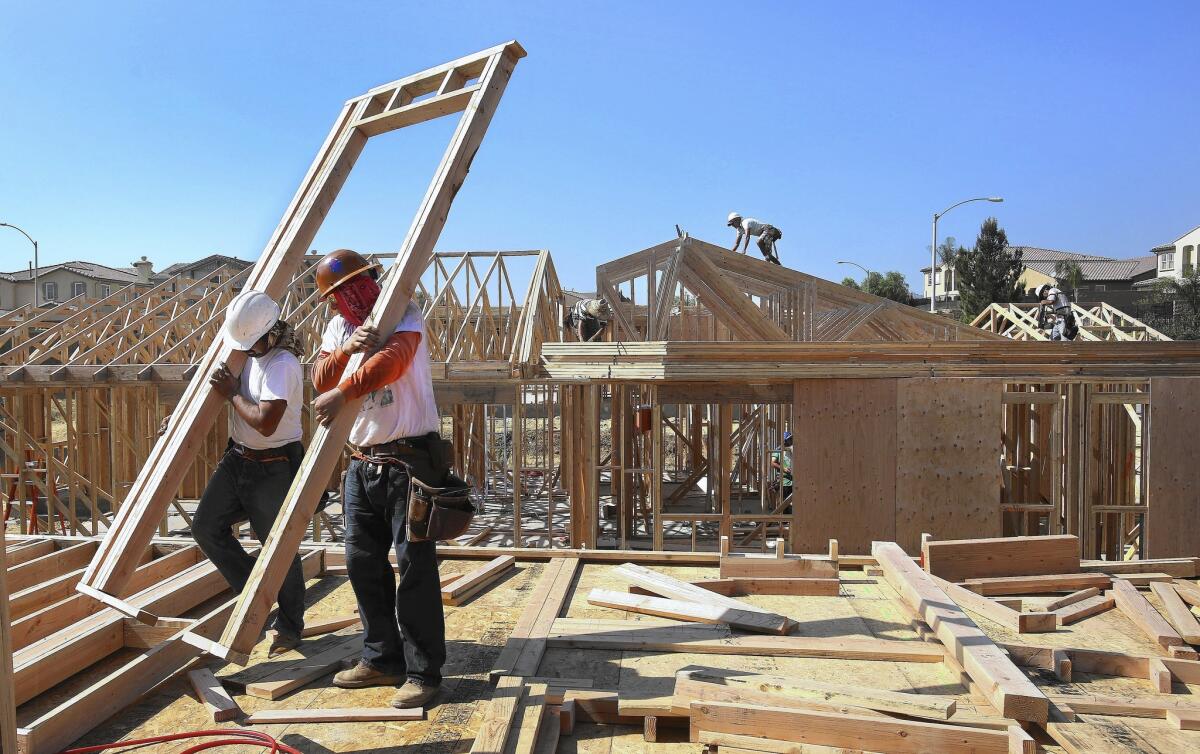In Southern California, new homes are rare and costly

- Share via
On a busy stretch of Sherman Way in Van Nuys, a red and black sign advertises a rare commodity in Los Angeles.
“Single detached homes. From the $400s,” it reads.
The 63 houses — “small lot” townhouses that sit less than six inches apart — are unusual in a region with few new houses selling for less than $500,000, and even fewer anywhere near Hollywood.
New home prices have soared in recent months, with the median for the six-county region peaking at $538,000 in June, according to CoreLogic DataQuick. In Orange County, the median new home price has topped $800,000.
A surge in higher-end projects has pushed new home prices above their pre-recession peaks, even as prices for existing homes remain one-fifth below their bubble-era highs.
Builders have piled in to pricey ZIP Codes — bidding up land costs there in the process — and polished their projects to a high gloss to woo wealthy buyers with cash or good credit.
“Builders have been focusing very heavily on the move-up market as opposed to entry level,” said Bradley Hunter, chief economist at housing research firm MetroStudy. “There’s a simple reason: That’s where the profits are.”
Meanwhile, projects aimed at the middle of the market remain scarce, and overall home building is off about 60% from a decade ago. The shortage of new lower-priced product is one factor making Southern California among the toughest housing markets in the country for middle-income families.
New homes have almost always sold at a premium. They come with bells and whistles — including energy-efficient appliances and often a warranty — that a decades-old house can’t match. But that premium has hit new highs this year.
In January, the gap between median-priced new and resale homes in Southern California peaked at $151,000, a 41% premium for a new house. And although it has eased a bit since, it has been larger than $100,000 in nine of the last 10 months, compared with an average of $38,000 over the last 25 years, according to CoreLogic’s figures. The same trend is playing out nationally, though in less dramatic fashion.
Still, demand for new homes remains strong. Sean Neininger was shopping in Valencia on Friday while he and his wife — both pilots — consider a move from to Southern California from Las Vegas. They’re focusing on new houses, and with two children and a lot of travel for work, they’re willing to pay extra to avoid the maintenance hassles of an older home.
“We’ve just always bought new,” Neininger said. “We bought a new house when we lived in Texas. If we decide to stay in Las Vegas, we’ll buy something new there too.”
Moving to Southern California won’t be cheap. The 4,100-square-foot “home within a home” they toured Friday — with an attached guest house — was listed at $772,000.
Several factors contribute to the widening price gap between new and resale homes, housing economists say.
The aftermath of the foreclosure crisis continues to weigh down the price of existing homes, particularly in lower-cost markets such as the Inland Empire. That’s also keeping builders on the sidelines there; they’re focusing in healthier areas.
Meanwhile, competing bids drove up the cost of land in prime areas in 2012 and 2013, said Rick Palacios, director of research at John Burns Real Estate Consulting. That’s translating into higher prices today. Some builders have made a conscious decision to move upmarket, figuring that wealthier consumers and higher-income areas just have more upside right now.
KB Home is among the builders moving upmarket. The Los Angeles builder, long a specialist in entry-level homes, has shifted to more affluent, “land-constrained” neighborhoods. They’re seeing results, especially in California. KB’s average selling price for its West Coast markets surged to $579,700 in the third quarter, a 21% jump from last year.
Those gains are partly being driven by Playa Vista, a Westside infill project where KB’s townhouses start at the decidedly-not-entry-level prices of $1.2 million. But it also reflects strong sales of $600,000 to $700,000 houses that KB is building in Santa Clarita and Irvine — some of the last chunks of L.A. and Orange counties with open land for building.
“There’s a lot of demand for new housing in locations where there just isn’t any available,” said Steven Ruffner, KB’s president for Southern California.
Higher-end home builders see this dynamic too, and they’re gobbling up what land is left. Luxury builder Toll Bros. acquired 3,200 lots in Southern California this year when it bought Shapell Homes, part of its plan to expand from its East Coast base into higher-growth markets. Now Toll is working on five new communities, from Santa Clarita to Carlsbad, in prime spots with good schools. It will start selling homes next year, said Jim Boyd, head of Toll’s California operations, and expects to do well.
“I think the market is pretty strong,” he said.
Sales have been brisk. In Valencia, where brightly colored signs point the way to new developments from several national builders, half-built frames share the block with newly bought homes decked out for Halloween. Price tags north of $600,000 are common.
Susan Blake, a sales agent for D.R. Horton’s Belmont subdivision, said she expects her 91-unit project to be sold out by spring, about two years after sales opened. A higher-end D.R. Horton project next door is down to its last dozen houses.
Business has picked up noticeably in the last year or so, Blake said, citing job growth in the Santa Clarita Valley, which is making the commute on the 5 Freeway to L.A. less of an issue. And the chance to buy new — and get a tankless water heater, solar hookups and a 10-year warranty — is attractive, even at a price that’s higher than what buyers might get on the resale market.
“People have busy lives. They don’t have time to do all this maintenance and worry about their house,” she said.
Many builders are trying to hit that no-worry, new-home niche at lower price points, even relatively close to the coast. They’re keeping prices down by building townhouses or other denser projects, like that small-lot project in Van Nuys.
These houses, and others like them, tend to compete more with resale homes than with new product further out, said Leonard Miller, California regional president for Richmond American, which is building the 63 homes in Van Nuys.
They’re priced accordingly, in line with the $420,000 median sales price in that ZIP Code. The houses on Sherman Way, and a comparably priced development in Pacoima, are drawing buyers who like the convenience of a new house without the commute that it often takes to afford one.
“When we drew up our business plan, we focused on being urban and closer to jobs,” Miller said. “There’s a lot of people who don’t want to commute 90 minutes or two hours.”
But there are also limits to how many people want townhouses. A lot of buyers still want space, and they’re willing to drive further to find it. That, along with growing demand if the economy keeps improving, is going to push new development back out toward the fringes of the region, Hunter of MetroStudy said. He’s already seeing more bidding wars for building sites in western Riverside County. That, in turn, will push down the median price of new homes and will create more entry-level opportunities. They’ll just be further out.
“It’s this inevitable process,” Hunter said. “That’s going to be a definite trend next year.”
Twitter: @bytimlogan
More to Read
Inside the business of entertainment
The Wide Shot brings you news, analysis and insights on everything from streaming wars to production — and what it all means for the future.
You may occasionally receive promotional content from the Los Angeles Times.










